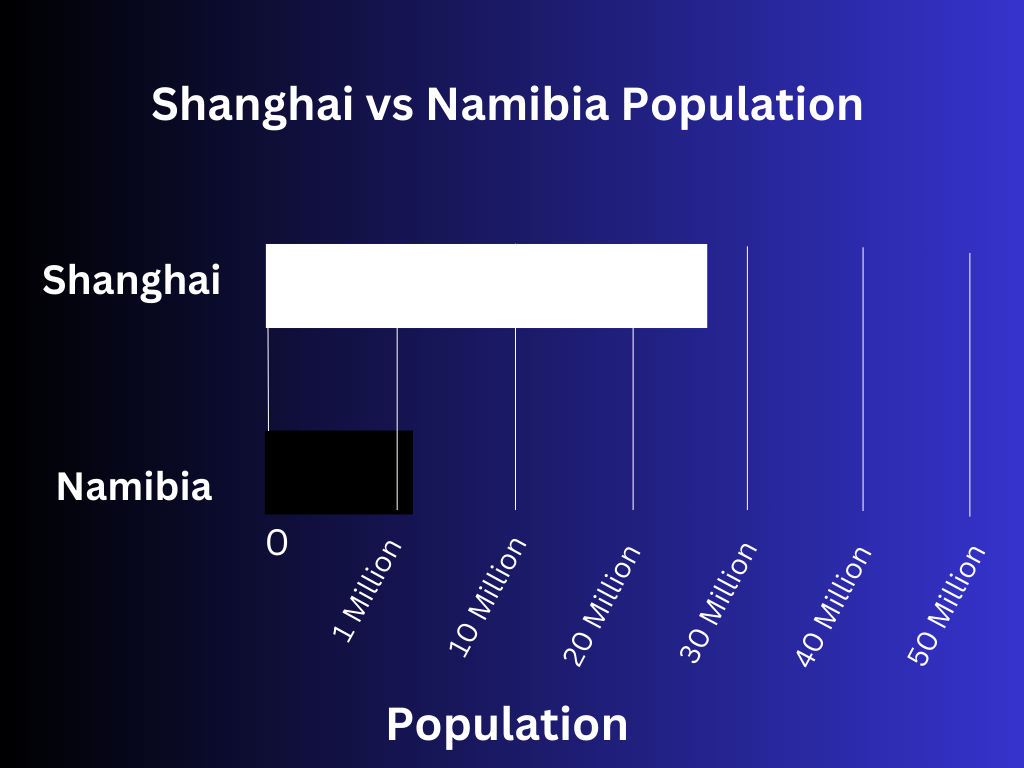
When it comes to comparing the size and population of different regions, it’s essential to delve into the numbers to truly understand the scale of each place. In this blog post, we will be comparing the vibrant city of Shanghai with the vast country of Namibia, exploring various aspects such as population, area, and population density.
Is Shanghai Bigger Than Namibia?
Yes Shanghai is Bigger Than Namibia. Shanghai has a population of 26,875,500 while Namibia is home to 2,777,232 residents. In terms of land area, Shanghai is 1,566,895.22 while Namibia is 204,013,909.5. Another comparison factor is the population density, Shanghai has a population Density of 4,200 per km2 while Namibia is 3.2 per KM2 .
Population

Shanghai, a global financial hub and one of the most populous cities in the world, boasts a staggering population of 26,875,500. On the other hand, Namibia, a country in southwestern Africa known for its diverse landscapes, has a significantly smaller population of 2,777,232. This stark contrast in population sets the stage for an intriguing exploration of urban density and its implications on lifestyle and infrastructure.
Area

Moving beyond population, the sheer geographical size of these two entities is another critical factor to consider. Shanghai covers an area of 1,566,895.22 acres, while Namibia spans a massive 204,013,909.5 acres. This vast difference in landmass raises questions about resource distribution, conservation efforts, and the overall impact on the environment.
Population Density
| State | Area (acres) | Population | Population Density |
| Shanghai | 1,566,895.22 | 26,875,500 | 4,200 |
| Namibia | 204,013,909.5 | 2,777,232 | 3.2 |
Population density is a key metric that provides insights into the concentration of people within a given area. Shanghai, with its impressive skyline and bustling streets, has a population density of 4,200/km². In contrast, Namibia, characterized by its expansive deserts and savannahs, has a much lower population density of 3.2/km². This significant gap in population density prompts reflections on urban planning, infrastructure, and the balance between rural and urban lifestyles.
Is It A Rich Or Poor Country?
Namibia, a country known for its breathtaking landscapes and diverse wildlife, has often been a subject of curiosity regarding its economic status. In this SEO article, we will explore the various factors that contribute to determining whether Namibia can be classified as a rich or poor country.
Economic Indicators
GDP per Capita
One of the primary indicators of a nation’s wealth is its Gross Domestic Product (GDP) per capita. Namibia, with its wealth of natural resources, has a GDP per capita that places it in the upper-middle-income category. This suggests a relatively higher standard of living compared to some other African nations.
Natural Resources
Namibia is rich in natural resources, including diamonds, uranium, and other minerals. The exploitation and export of these resources contribute significantly to the country’s revenue. However, the challenge lies in ensuring that the benefits of these resources are distributed equitably across the population.
Income Inequality
While Namibia’s overall economic indicators may suggest a certain level of prosperity, it’s crucial to examine income distribution. Like many countries, Namibia faces challenges related to income inequality. Disparities between urban and rural areas, as well as among different population groups, present a complex picture of wealth distribution.
Economic Challenges
Unemployment
Despite its resource wealth, Namibia grapples with high unemployment rates, particularly among the youth. This economic challenge raises questions about the inclusivity of growth and the need for diversified economic strategies to create more job opportunities.
Dependence on External Factors
Namibia’s economy is vulnerable to external factors such as global commodity prices. The fluctuations in these prices can impact the country’s revenue from exports, highlighting the importance of economic diversification for long-term stability.
In conclusion, labeling Namibia as either a rich or poor country is a nuanced task. The nation possesses considerable natural wealth, contributing to a relatively higher GDP per capita. However, challenges such as income inequality and unemployment underscore the complexities within Namibia’s economic landscape.
As we’ve seen, Namibia’s economic status is not a straightforward binary. It’s a nation with both wealth and challenges, a dynamic mix that requires careful consideration. Whether Namibia will continue to build on its economic strengths or address the existing challenges will play a pivotal role in shaping its future.
For those seeking to understand Namibia’s economic standing, this exploration provides a foundation for a more nuanced perspective, emphasizing the need for sustainable economic practices and inclusive growth.
In summary, the numbers tell a compelling story of the disparities between Shanghai and Namibia. Shanghai, with its dense population and limited space, reflects the challenges and opportunities of urban living on a grand scale. Meanwhile, Namibia’s vast expanse raises questions about sustainability, conservation, and the coexistence of human populations with the natural world.
In over 600 words, we’ve explored the population, area, and population density of Shanghai and Namibia. This comparison invites further reflection on the dynamic relationship between human societies and the environments they inhabit. As we navigate an increasingly interconnected world, understanding these differences becomes crucial for informed decision-making and sustainable development.
